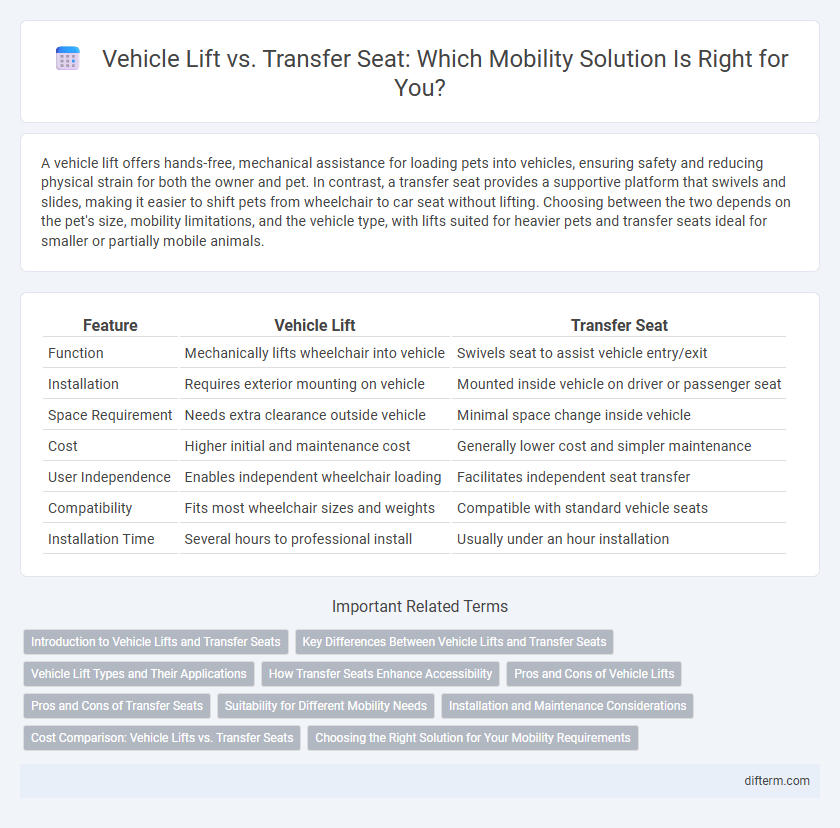A vehicle lift offers hands-free, mechanical assistance for loading pets into vehicles, ensuring safety and reducing physical strain for both the owner and pet. In contrast, a transfer seat provides a supportive platform that swivels and slides, making it easier to shift pets from wheelchair to car seat without lifting. Choosing between the two depends on the pet's size, mobility limitations, and the vehicle type, with lifts suited for heavier pets and transfer seats ideal for smaller or partially mobile animals.
Table of Comparison
| Feature | Vehicle Lift | Transfer Seat |
|---|---|---|
| Function | Mechanically lifts wheelchair into vehicle | Swivels seat to assist vehicle entry/exit |
| Installation | Requires exterior mounting on vehicle | Mounted inside vehicle on driver or passenger seat |
| Space Requirement | Needs extra clearance outside vehicle | Minimal space change inside vehicle |
| Cost | Higher initial and maintenance cost | Generally lower cost and simpler maintenance |
| User Independence | Enables independent wheelchair loading | Facilitates independent seat transfer |
| Compatibility | Fits most wheelchair sizes and weights | Compatible with standard vehicle seats |
| Installation Time | Several hours to professional install | Usually under an hour installation |
Introduction to Vehicle Lifts and Transfer Seats
Vehicle lifts and transfer seats are essential mobility aids designed to facilitate easier access in and out of vehicles for individuals with limited mobility. Vehicle lifts typically operate with hydraulic or electric mechanisms to lift wheelchairs directly into the vehicle, offering stability and safety during transfers. Transfer seats swivel and slide to assist users in moving from a wheelchair to the vehicle seat, providing a practical solution where space or vehicle modifications are limited.
Key Differences Between Vehicle Lifts and Transfer Seats
Vehicle lifts provide a mechanical platform to raise and lower a wheelchair user directly into a vehicle, enabling easy entry without requiring the user to transfer out of their wheelchair. Transfer seats swivel and slide, allowing the user to move from their wheelchair onto the vehicle seat independently or with assistance, emphasizing a smoother transition rather than lifting. Key differences include the level of user independence, with transfer seats enhancing self-transfer capability, while vehicle lifts depend on mechanical assistance and accommodate a broader range of mobility devices.
Vehicle Lift Types and Their Applications
Hydraulic lifts provide smooth and reliable vehicle access, ideal for heavy mobility devices and frequent use in personal vans or commercial vehicles. Electric lifts offer quieter operation and precise control, suitable for users requiring easy and automated wheelchair boarding. Manual lifts are cost-effective solutions for occasional use and smaller vehicles, emphasizing simplicity and ease of maintenance.
How Transfer Seats Enhance Accessibility
Transfer seats significantly enhance accessibility by enabling effortless movement between a vehicle and a wheelchair, reducing physical strain for users with limited mobility. These seats rotate and slide outward, providing a seamless transition that increases safety and independence during vehicle entry and exit. Unlike traditional vehicle lifts, transfer seats offer a more compact, user-friendly solution that adapts to various vehicle types without requiring extensive modifications.
Pros and Cons of Vehicle Lifts
Vehicle lifts provide exceptional accessibility for wheelchair users by allowing the entire wheelchair to be lifted into the vehicle, preserving user posture and minimizing transfer effort. These systems are versatile, accommodating a wide range of wheelchair sizes and weights, but they often require significant vehicle modifications and can be costly to install and maintain. Compared to transfer seats, vehicle lifts offer greater independence but may increase loading time and necessitate regular mechanical upkeep.
Pros and Cons of Transfer Seats
Transfer seats offer enhanced accessibility by swiveling and extending outside the vehicle, simplifying entry and exit for individuals with mobility challenges. They require less vehicle modification compared to lifts, reducing installation costs and preserving vehicle aesthetics. However, transfer seats may have weight limitations and less versatility for heavy or bulky mobility devices compared to vehicle lifts.
Suitability for Different Mobility Needs
Vehicle lifts provide an ideal solution for individuals requiring wheelchair accessibility, offering seamless and secure entry for heavy mobility devices. Transfer seats are better suited for users who maintain some upper body strength and seek easier transitions between the seat and the vehicle without the need for full wheelchair accommodation. Selecting between a vehicle lift and transfer seat depends on the user's specific mobility level, vehicle type, and personal independence requirements.
Installation and Maintenance Considerations
Vehicle lifts require professional installation due to their complex mechanical and electrical systems, ensuring safety and compliance with regulations. Transfer seats offer simpler installation, often requiring minimal modifications and tools, making them more suitable for quick deployment in various vehicles. Maintenance for vehicle lifts involves regular inspections, lubrication, and potential repairs to hydraulic or motor components, whereas transfer seats typically require less frequent upkeep focused on seat mechanisms and electrical connections.
Cost Comparison: Vehicle Lifts vs. Transfer Seats
Vehicle lifts generally have higher upfront costs, ranging from $1,500 to $5,000, compared to transfer seats, which typically cost between $500 and $2,000. Installation expenses for vehicle lifts can add $300 to $1,000, depending on vehicle type, while transfer seats often require minimal or no professional installation. Long-term maintenance and repair costs tend to be higher for vehicle lifts due to mechanical complexity, whereas transfer seats are simpler and more affordable to maintain.
Choosing the Right Solution for Your Mobility Requirements
Selecting the appropriate mobility aid depends on individual needs, space constraints, and vehicle compatibility. Vehicle lifts provide a versatile, durable option for wheelchair users requiring secure transport, while transfer seats offer a compact, cost-effective alternative for those with limited mobility but maintaining some transfer ability. Assessing lifestyle, vehicle type, and frequency of use ensures the right balance between convenience and accessibility in mobility solutions.
vehicle lift vs transfer seat Infographic

 difterm.com
difterm.com